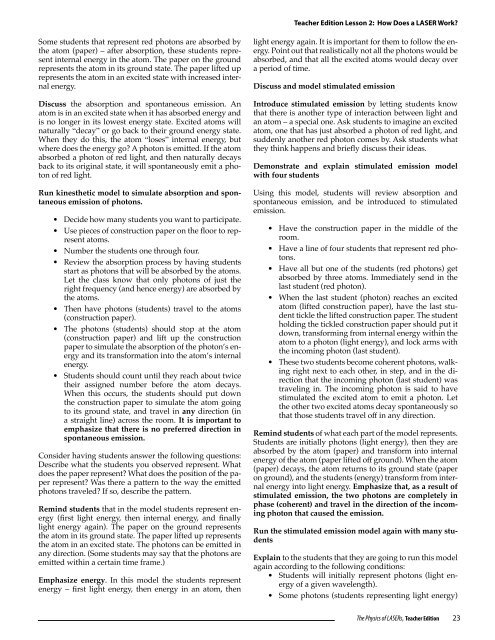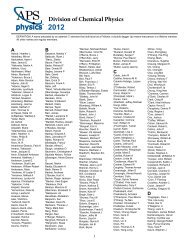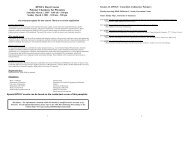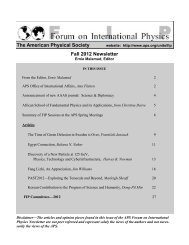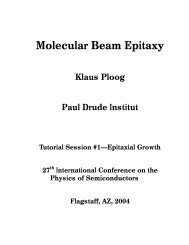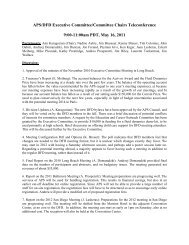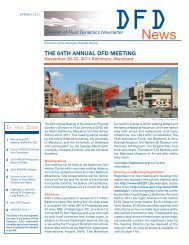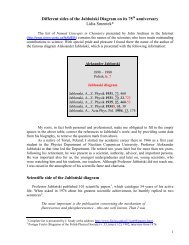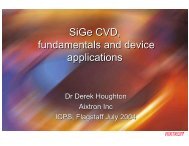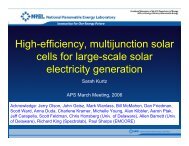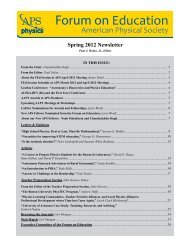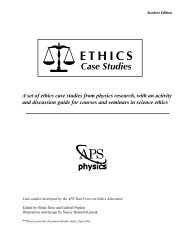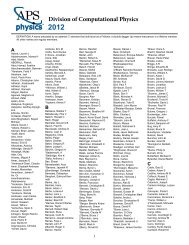The Physics of LASERs - American Physical Society
The Physics of LASERs - American Physical Society
The Physics of LASERs - American Physical Society
Create successful ePaper yourself
Turn your PDF publications into a flip-book with our unique Google optimized e-Paper software.
Some students that represent red photons are absorbed by<br />
the atom (paper) – after absorption, these students represent<br />
internal energy in the atom. <strong>The</strong> paper on the ground<br />
represents the atom in its ground state. <strong>The</strong> paper lifted up<br />
represents the atom in an excited state with increased internal<br />
energy.<br />
Discuss the absorption and spontaneous emission. An<br />
atom is in an excited state when it has absorbed energy and<br />
is no longer in its lowest energy state. Excited atoms will<br />
naturally “decay” or go back to their ground energy state.<br />
When they do this, the atom “loses” internal energy, but<br />
where does the energy go? A photon is emitted. If the atom<br />
absorbed a photon <strong>of</strong> red light, and then naturally decays<br />
back to its original state, it will spontaneously emit a photon<br />
<strong>of</strong> red light.<br />
Run kinesthetic model to simulate absorption and spontaneous<br />
emission <strong>of</strong> photons.<br />
• Decide how many students you want to participate.<br />
• Use pieces <strong>of</strong> construction paper on the floor to represent<br />
atoms.<br />
• Number the students one through four.<br />
• Review the absorption process by having students<br />
start as photons that will be absorbed by the atoms.<br />
Let the class know that only photons <strong>of</strong> just the<br />
right frequency (and hence energy) are absorbed by<br />
the atoms.<br />
• <strong>The</strong>n have photons (students) travel to the atoms<br />
(construction paper).<br />
• <strong>The</strong> photons (students) should stop at the atom<br />
(construction paper) and lift up the construction<br />
paper to simulate the absorption <strong>of</strong> the photon’s energy<br />
and its transformation into the atom’s internal<br />
energy.<br />
• Students should count until they reach about twice<br />
their assigned number before the atom decays.<br />
When this occurs, the students should put down<br />
the construction paper to simulate the atom going<br />
to its ground state, and travel in any direction (in<br />
a straight line) across the room. It is important to<br />
emphasize that there is no preferred direction in<br />
spontaneous emission.<br />
Consider having students answer the following questions:<br />
Describe what the students you observed represent. What<br />
does the paper represent? What does the position <strong>of</strong> the paper<br />
represent? Was there a pattern to the way the emitted<br />
photons traveled? If so, describe the pattern.<br />
Remind students that in the model students represent energy<br />
(first light energy, then internal energy, and finally<br />
light energy again). <strong>The</strong> paper on the ground represents<br />
the atom in its ground state. <strong>The</strong> paper lifted up represents<br />
the atom in an excited state. <strong>The</strong> photons can be emitted in<br />
any direction. (Some students may say that the photons are<br />
emitted within a certain time frame.)<br />
Emphasize energy. In this model the students represent<br />
energy – first light energy, then energy in an atom, then<br />
Teacher Edition Lesson 2: How Does a LASER Work?<br />
light energy again. It is important for them to follow the energy.<br />
Point out that realistically not all the photons would be<br />
absorbed, and that all the excited atoms would decay over<br />
a period <strong>of</strong> time.<br />
Discuss and model stimulated emission<br />
Introduce stimulated emission by letting students know<br />
that there is another type <strong>of</strong> interaction between light and<br />
an atom – a special one. Ask students to imagine an excited<br />
atom, one that has just absorbed a photon <strong>of</strong> red light, and<br />
suddenly another red photon comes by. Ask students what<br />
they think happens and briefly discuss their ideas.<br />
Demonstrate and explain stimulated emission model<br />
with four students<br />
Using this model, students will review absorption and<br />
spontaneous emission, and be introduced to stimulated<br />
emission.<br />
• Have the construction paper in the middle <strong>of</strong> the<br />
room.<br />
• Have a line <strong>of</strong> four students that represent red photons.<br />
• Have all but one <strong>of</strong> the students (red photons) get<br />
absorbed by three atoms. Immediately send in the<br />
last student (red photon).<br />
• When the last student (photon) reaches an excited<br />
atom (lifted construction paper), have the last student<br />
tickle the lifted construction paper. <strong>The</strong> student<br />
holding the tickled construction paper should put it<br />
down, transforming from internal energy within the<br />
atom to a photon (light energy), and lock arms with<br />
the incoming photon (last student).<br />
• <strong>The</strong>se two students become coherent photons, walking<br />
right next to each other, in step, and in the direction<br />
that the incoming photon (last student) was<br />
traveling in. <strong>The</strong> incoming photon is said to have<br />
stimulated the excited atom to emit a photon. Let<br />
the other two excited atoms decay spontaneously so<br />
that those students travel <strong>of</strong>f in any direction.<br />
Remind students <strong>of</strong> what each part <strong>of</strong> the model represents.<br />
Students are initially photons (light energy), then they are<br />
absorbed by the atom (paper) and transform into internal<br />
energy <strong>of</strong> the atom (paper lifted <strong>of</strong>f ground). When the atom<br />
(paper) decays, the atom returns to its ground state (paper<br />
on ground), and the students (energy) transform from internal<br />
energy into light energy. Emphasize that, as a result <strong>of</strong><br />
stimulated emission, the two photons are completely in<br />
phase (coherent) and travel in the direction <strong>of</strong> the incoming<br />
photon that caused the emission.<br />
Run the stimulated emission model again with many students<br />
Explain to the students that they are going to run this model<br />
again according to the following conditions:<br />
• Students will initially represent photons (light energy<br />
<strong>of</strong> a given wavelength).<br />
• Some photons (students representing light energy)<br />
<strong>The</strong> <strong>Physics</strong> <strong>of</strong> <strong>LASERs</strong>, Teacher Edition<br />
23


